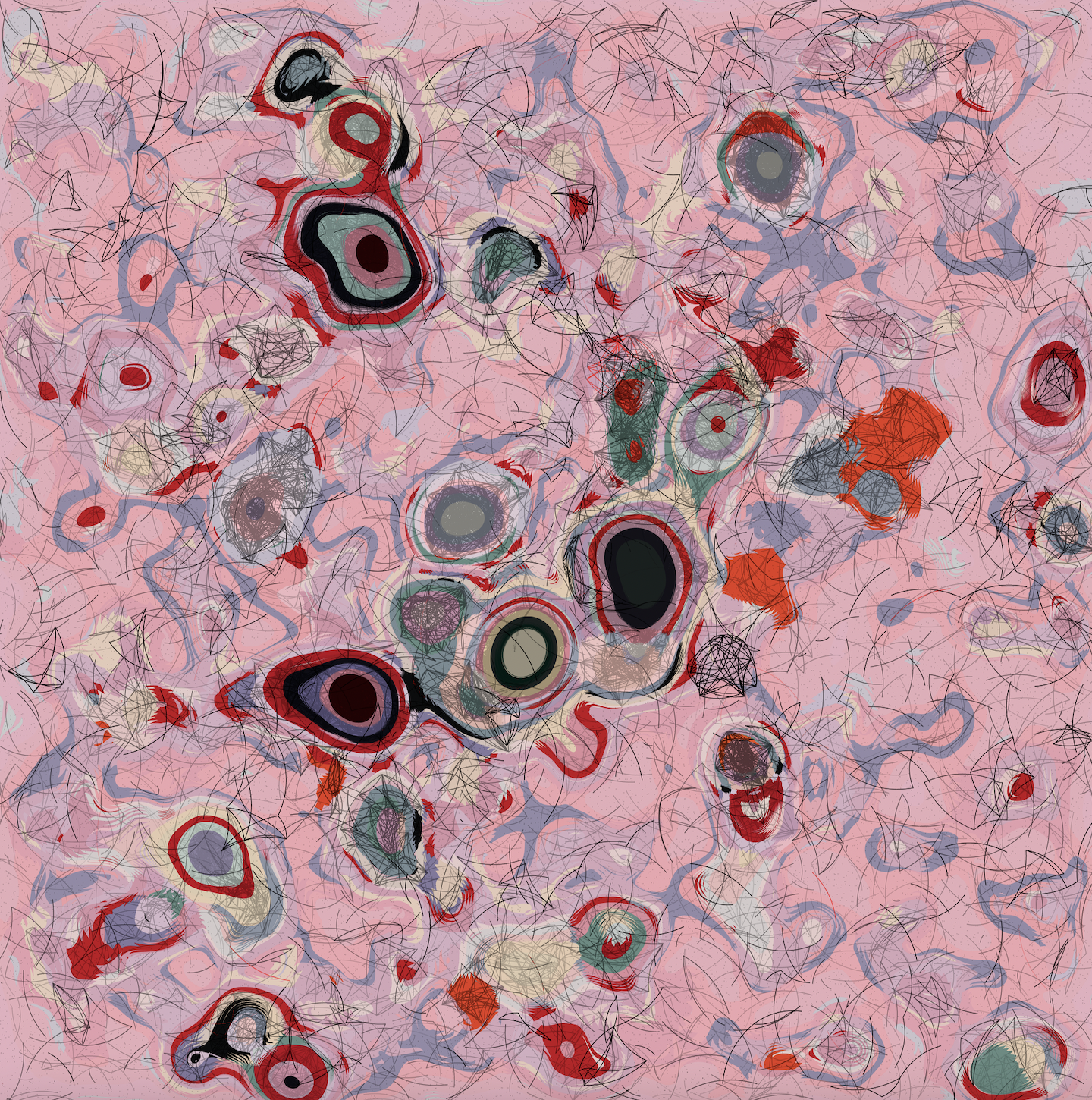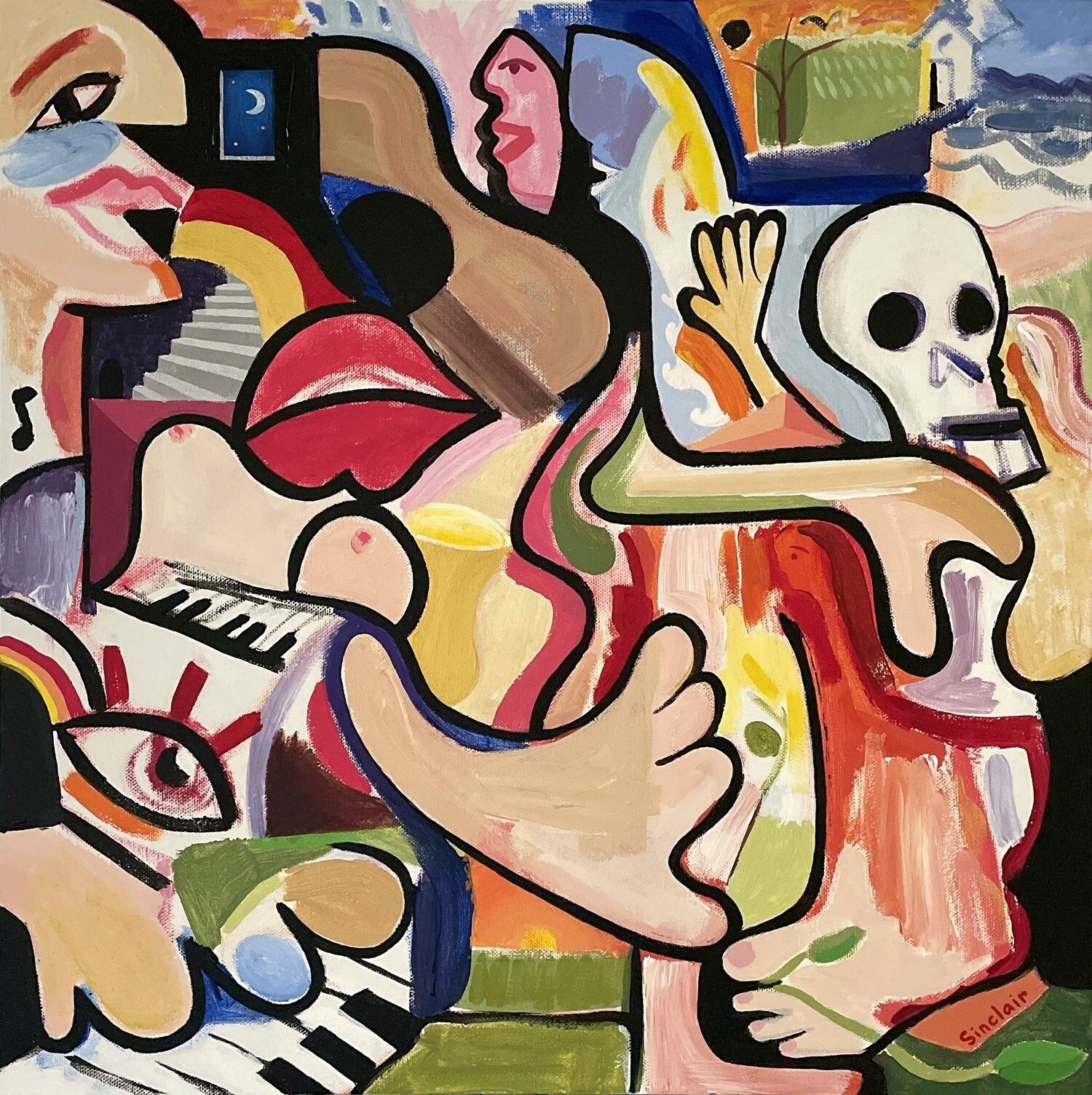
About the artist:
Olivier Bodini has spent three decades immersed in his scientific research, exploring objects that embody and dissect the intricacy and beauty in both complexity and structure. However, he suggests that these attributes alone do not necessarily render objects beautiful or artistically significant. Drawing on the principles of Darwinian evolution, Bodini asserts that visual perception in animals has evolved to capture crucial information from their environment. Bodini's work bridges the gap between science and art by examining the primal functions of vision. He believes that understanding the fundamental mechanisms of visual perception can elucidate what satisfies the human eye when it encounters various objects. Though not an expert in art theories, Bodini interprets them through a scientific lens, suggesting that these theories, in their historical and societal contexts, attempt to describe the very phenomena he investigates.
Central to Bodini's framework is the concept of the "power law" from mathematics. This law describes the size distribution that objects in the visual field must follow to achieve visual satisfaction. Interestingly, this same distribution pattern emerges in the interaction graphs of social networks like Twitter and Facebook. Bodini's artwork captures these interactions, reflecting their complexity, structure, and adherence to the power law.
Through his tables and visual representations, Bodini masterfully translates the intricate dynamics of social interactions into visually compelling artforms. His work is a testament to his belief in the deep connection between scientific principles and artistic expression, consistently yielding results that bring him great satisfaction.
Bodini is currently working and living in Paris, France, where he is a computer science professor at Université Sorbonne Paris Nord. His work has been exhibited during Art Basel Paris 2022, Galerie Charlot, Galerie Data, and Expanded Art.
About the work:
In his latest piece, inspired by the French expression voir “la vie en rose," Bodini interprets the human desire for happiness in a world fraught with conflict. Using generative algorithms, the work reflects the organic nature of our relationships, with networks of interconnected forms symbolizing the ways we group ideologically, while vibrant colors represent the nuances of these connections. Through this, Bodini masterfully creates a harmony of forms, suggesting the possibility of interconnectedness despite underlying complexities.
Bodini’s practice delves into the primal functions of vision, questioning what truly satisfies the human eye. By applying scientific principles to artistic expression, he bridges the gap between disciplines, creating works that are both aesthetically compelling and conceptually rigorous.
The interview:
Paloma: Can you tell me a bit about your background and how or when you were first interested in art?
Olivier: I hold a PhD in Mathematics, and science has always been a sanctuary for me. In mathematics, there are no opinions—either you prove a theorem, or you don’t. There’s no room for controversy, and that brings me a great sense of comfort. I cherish that emotional stability. In contrast, I dislike disputes. People often clash because they don’t share the same value systems or priorities, trying to justify their positions without realizing there’s nothing to prove—it’s simply a matter of different perspectives.
So, while mathematics provides me comfort, nothing, in my view, holds more value than the arts. The act of artistic creation, to me, best defines our species. We possess this incredible ability to create—even to create things that serve no utilitarian purpose. Humans create for the sheer pleasure of challenging their senses. Art has always been a constant and fundamental part of my life. I’ve practiced music and composition extensively, and graphic arts have always been around me, even though I didn’t pursue formal education in that direction.
Both art and mathematics are intricate, structured, and elegant abstract constructs. I believe I experience the same sense of joy when gazing at a Vermeer painting as I do when reading a beautifully crafted mathematical proof. The key difference is that art is open to endless debate. No one can definitively say what art is or what defines beauty; it’s shaped by an elaborate social construct. That’s why, I think, I took a long time to identify myself as an artist. I needed enough stability and experience to embrace criticism, debate, and even misunderstanding.
Paloma: Your work merges scientific principles with artistic expression. Are there any particular art movements or artists that resonate with you or inspire your practice? How do these movements align with your exploration of visual perception, complexity, and the mathematical foundations of beauty?
Olivier: It would be rather predictable to say that I have a particular affection for Maurits Cornelis Escher. But to be honest, my approach has not really been based on examples of artists who have bridged the gap between art and science. I am also not a follower of the perfect beauty of mathematics. I believe that art doesn't much like perfect symmetry; I am more inclined to think that art is founded on organization and complexity.
“It is on this idea of the perception of complexity that I defined my initial artistic concepts: creating structured, complex models that can be grasped by humans. The key concept here is interpretability.” - Olivier

Wang tiling. (Digital Nymphea by O. Bodini, 2022)
The human brain is an incredible machine, but it has limits that shouldn't be exceeded. Some neuroscientists refer to this as cognitive overload. The same happens when an individual is faced with a piece of art. Imagine walking into the Sistine Chapel: you're struck by awe, overwhelmed by the masterpiece. But if Michelangelo had done more, it could have been too much. If the Sistine Chapel were 200m by 100m, our cognition would likely have been overloaded, overwhelmed, leaving the viewer disoriented and confused. I firmly believe in this threshold of sensory saturation. It's this fine line that I humbly try to reach in my work—the right amount of information to captivate the brain, but not overwhelm it.
Paloma: Your work deeply explores the intersection of science and art, particularly through the lens of visual perception. Can you share what first sparked your interest in studying the primal functions of vision and how that evolved into artistic expression?

The Sad Clown, 2023 By Olivier Bodini
Olivier: Art fascinates me. I am incredibly receptive, deeply sensitive to all its forms of expression. It’s a bit embarrassing, but I often find myself moved to tears in front of a monument, a sculpture, a painting, or while listening to a piece of music. From a young age, I had the idea that art is like a distilled essence of humanity—a perfume, if you will. An artist can spend years creating a masterpiece, which, in itself, concentrates all that time and effort, a sort of condensation of human emotion.
“I've always told myself that I wanted to understand why I am so deeply affected by art. And today, I believe in this idea of sensory and cognitive saturation—a kind of mental effervescence that I aim to recreate in my own work.” - Olivier

The beginning of life by O. Bodini (2022), owned by W. Mapan
Paloma: The power law is central to your framework for understanding visual satisfaction. How did you initially come across this concept, and what inspired you to apply it to both social networks and art?

Data Visualization Algorithm Development by O. Bodini (Brain tumor data).
Olivier: It happened somewhat by chance. I work on a research team in a field called combinatorics, a branch of mathematics dealing with combinations of objects belonging to a finite set in accordance with certain constraints, such as those of graph theory. The team down the hall was working on community detection in networks. One day, I saw one of their team's posters, and I was fascinated—it was visually stunning, even though their main focus was simply to visualize interactions and groupings. That’s when I started working on data visualization algorithms, not only to try to improve them, but also to understand why I found them so aesthetically pleasing. During that research, I stumbled upon an article by Federico Etro and Elena Stepanova: Power-laws in art, Physica A: Statistical Mechanics and its Applications, Volume 506, 2018, Pages 217-220. It really intrigued me, as social networks are also organized around power laws, and I found the paper’s arguments to be quite compelling. Moreover, it aligned well with my own "theory" of sensory limits in perception.
“After all, visual arts play with our senses (Vasarely and kinetic art, Seurat with pointillism, the golden ratio, etc.), so our sensory capacities are, in a way, implicitly factored into the artist’s equation or process when they create.” - Olivier

Lacerta, 1955 by Victor Vasarely
A Sunday on La Grande Jatte, 1884 by Georges Seurat (left), Detail shot (right)
Visuals in fine art have the ability to play with our sensory perception, particularly through techniques that manipulate visual elements to engage the viewer's senses in unique ways.
The Last Supper, 1494-1499 by Leonardo Da Vinci
Paloma: You often allude to the interpretation of art theories through a scientific lens, how do you perceive the historical evolution of these theories in relation to your own work? Do you see parallels between the development of art movements and scientific advancements?
Olivier: Art and science are distinct disciplines, yet they share many similarities. Both involve creation, passion, and dissemination, and their histories are intertwined through technical and theoretical advancements that have influenced art—perspective, color theory, anatomy, photography, cinema, and now AI. I deliberately keep my artistic and scientific practices separate because their goals differ: art pursues beauty, while science seeks truth. However, science fuels my imagination and serves as my artistic tool. For me, algorithms are the medium that bridges this gap. They are flexible, adaptable, and allow me to explore power-law structures, hierarchical complexity, and, most importantly, conceptual breakthroughs. While we haven't yet discussed this, I believe that having a unique style is crucial for any artist. A fresh perspective is what drives innovation, and that's what I strive to achieve through my algorithmic approach.
 Is-mic-la tiling III, 2023 by Olivier Bodini
Is-mic-la tiling III, 2023 by Olivier Bodini
Paloma: How do you envision the future of art, especially as technology and scientific understanding continue to evolve? Do you think there will be a growing interest in art that explores these intersections, like your own work?
Olivier: To be honest, I’m not even sure how humanity will cope with the immense changes it's undergoing! AI is going to disrupt all of our social models—work, human relationships... and the arts! For me, AI represents a second Copernican revolution. Just as Copernicus’ heliocentrism displaced humanity from the center of the universe, AI challenges our abilities. Today, AI questions our competencies. It surpasses us in many simple tasks, and the progress in learning models is so rapid that I struggle to grasp its limits. After all, deep learning is based on mimicking the brain. Right now, we are far from understanding all neural mechanisms, but AI is like a primitive version of ourselves. It holds up an uncomfortable mirror: our thought processes might very well be just an algorithm. Apologies if this is unsettling, just as heliocentrism once was, but science is humbling human vanity.
I feel I should clarify: Life is fascinating, incredible, and in my eyes, beyond what we could have hoped for. I believe humanity needs to recognize this before a catastrophe strikes. However, humans have always assigned themselves a singular role among living beings. I think it's time for a bit more humility, and I believe AI is going to teach us that lesson!
Paloma: Let's talk about your latest work titled The Pink Cells, can you tell me a bit more about this specific piece and what inspired it?

The Pink Cells by Olivier Bodini
Olivier: So far, I’ve spoken at length about the composition and power laws that structure my work, but I haven't touched on color! Yet, how can we think about visual art without colors? So, in this particular work I embarked on an important exploration of color palettes. Can we ask a computer to invent a color palette? Of course, deep learning can do it—you just need to extract color palettes from tens of thousands of artworks and train them!
However, I consider myself an artist, so I continued refining my algorithm until I found a color palette that truly resonates with me. That said, I often feel a sense of frustration with digital art, as colors are a delicate alchemy—much like crafting French pastries, where precision in quantities is crucial. The challenge arises because everyone views digital artworks on screens with varying calibrations, brightness, and contrast. It's frustrating to think about how those subtle nuances, which I've spent so much time perfecting, can shift or even lose their intended impact depending on the viewer's display.
As for the composition of the piece, I applied the paradigms I mentioned earlier: power law structures, and a hierarchical complexity threshold. The algorithm constructs fluid shapes that organize themselves like a branching tree.
Paloma: You mentioned the French phrase “Voir la vie en rose” or to see life in pink. How do you think the visual language of algorithms and generative art can effectively convey these complex emotions and societal tensions?
Olivier: I believe that art has the ability to influence our moods and emotional reactions! But in this piece, I especially wanted to express my dismay at the current state of the world, where individuals and our leaders spend more time highlighting our differences rather than celebrating our similarities. Despite our diverse backgrounds, every human being shares similar fundamental desires. Through my travels for research, I’ve visited many countries across all continents and under various political regimes, and one universal truth stands out: people, at their core, simply want to be happy with their loved ones. In this work, I aimed to explore and visually express that shared longing for happiness, while also touching on the societal tensions that often obscure it.
So, I thought expressing universal happiness in a piece of art could be a meaningful goal. This work is intended as a metaphor for our shared humanity: the cells represent ideological groups, but everything is interconnected, and beyond our differences, we form a single whole. Sometimes I think that if an imminent threat to all life on Earth arose, we would finally learn to communicate for the common good.
See more of Olivier's work on SuperRare here




